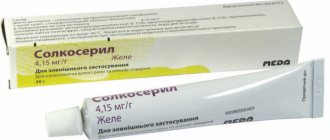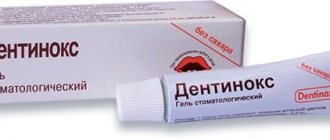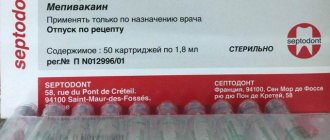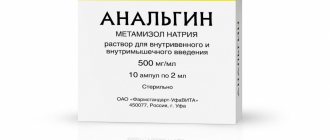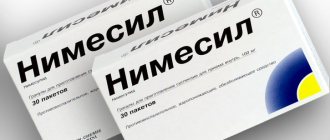Instructions for use ANALGIN
When using the drug, agranulocytosis may develop, and therefore, if an unmotivated increase in temperature, chills, sore throat, difficulty swallowing, stomatitis, as well as inflammation of the external genitalia and anus are detected, immediate discontinuation of the drug is necessary.
The risk of potentially severe anaphylactoid reactions to Analgin increases significantly in patients with:
- asthma syndrome or angioedema to non-narcotic analgesics;
- bronchial asthma with concomitant rhinosinusitis and nasal polyps, chronic urticaria,
- intolerance to dyes (tartrazine) and preservatives (benzoates);
- alcohol intolerance.
When prescribed to patients with acute cardiovascular pathology, careful monitoring of hemodynamics is necessary due to the hypotensive effect. Use with caution in patients with blood pressure levels below 100 mmHg. Art., with myocardial infarction, multiple trauma, with anamnestic indications of liver and kidney diseases (pyelonephritis, glomerulonephritis), during treatment with cytostatics, blood diseases. The risk of such reactions is also increased in patients with dehydration or dehydration, unstable blood pressure or incipient circulatory failure (for example, in patients with multiple injuries or a heart attack), in patients with high fever.
These patients require careful evaluation and close monitoring. Preventive measures (such as circulatory stabilization) may be necessary to reduce the risk of hypotensive reactions.
In exceptional cases, Analgin can be used in patients in whom a decrease in blood pressure is unacceptable, for example, with severe coronary heart disease or corresponding stenosis of the cerebral arteries. In such cases, the use of Analgin is possible only after careful monitoring of hemodynamic parameters.
In patients with renal or hepatic impairment, Analgin should be taken only after a careful assessment of the benefits, risks and necessary precautions.
In patients with an increased risk of anaphylactic reactions, Analgin can be used only after a thorough analysis of the possible risks in relation to the expected benefits. When taking Analgin in such cases, the patient should be carefully monitored to ensure medical care and emergency preparedness.
It is unacceptable to use the drug to relieve acute abdominal pain (until the cause is determined).
It is possible that the urine may turn red due to the release of a metabolite (it does not matter).
Impact on the ability to drive vehicles and operate machinery
The recommended dosage range does not affect the concentration or rate of reaction. As a precaution, avoid driving cars, vehicles, or other hazardous activities while taking high doses.
Analgin 500 mg No. 10 tablet.
APPROVED by the Order of the Chairman of the Committee for Control of Medical and Pharmaceutical Activities of the Ministry of Health and Social Development of the Republic of Kazakhstan dated "____" __________ 20___ No. ______ Instructions for the medical use of the drug ANALGIN Trade name Analgin International nonproprietary name Metamizole sodium Dosage form Tablets 500 mg Composition One tablet contains: active substance - metamizole sodium 500.0 mg, excipients: sucrose, talc, potato starch, calcium stearate. Description Tablets are white or white with a slightly yellowish tint, flat-cylindrical in shape with a chamfer and a score. Pharmacotherapeutic group: Other analgesics-antipyretics. Pyrazolones. Metamizole sodium ATC code N02BB02 Pharmacological properties Pharmacokinetics When taken orally, it is quickly and completely absorbed. There is no unchanged metamizole in the blood. Excreted by the kidneys in the form of metabolites. Metabolites are excreted in breast milk. The action develops after 20-40 minutes and reaches a maximum after 2 hours. The maximum concentration is achieved 1-1.5 hours after parenteral administration. The half-life is approximately 7 hours. Metabolites are completely excreted in the urine, 71% of the administered dose is detected in the interval from 0 to 24 hours, 18% - from 24 to 48 hours. Pharmacodynamics Analgin has analgesic, antipyretic and weak anti-inflammatory effects. It is a derivative of pyrazolone. The mechanism of action is associated with inhibition of the activity of cyclooxygenase types I and II. As a result, the reactions of the arachidonic cascade of eicosanoid synthesis are blocked and the formation of prostaglandins PgE2, PgF2α, their endoperoxides, and bradykinin is disrupted. In the nuclei of the antinociceptive system, analgin enhances the release of kynurenic acid, which inhibits the conduction of pain impulses (due to its effect on NMDA receptors). It prevents the transmission of pain impulses from extra- and proprioceptive receptors along the Gaulle and Burdach bundles, and increases the threshold of excitability of the pain centers of the thalamus. At the same time, it enhances heat transfer and reduces the activity of the temperature-setting center of the hypothalamus. Indications for use: pain, mild or moderate (headache, toothache, neuralgia, myalgia, dysmenorrhea, postoperative pain) - febrile conditions in infectious and inflammatory diseases. Method of administration and dosage: 1 tablet 2-3 times a day after meals. The maximum single dose is 1 g, the daily dose is 3 g. Adults and children over 15 years of age are prescribed 250-500 mg (½-1 tablet) 2-3 times a day. The duration of administration is no more than 5 days when prescribed as an analgesic and no more than 3 days when prescribed as an antipyretic. Side effects Rarely - nausea, vomiting, anorexia, pain in the epigastric region, flatulence, constipation, diarrhea - headache, dizziness, agitation, irritability - allergic reactions (skin rash, itching, angioedema), exudative erythema multiforme (Stevens-Johnson syndrome ), toxic epidermal necrolysis (Lyell's syndrome), bronchospastic syndrome, anaphylactic shock - paresthesia, tinnitus, blurred vision, tremor, depression - agranulocytosis, leukopenia, anemia, thrombocytopenia (with long-term use) - arterial hypotension, heart rhythm disturbances - oliguria , anuria, proteinuria, renal dysfunction, interstitial nephritis Contraindications - hypersensitivity to analgin, other pyrazolone derivatives (phenylbutazone, tribuzone) or other excipients of the drug - deficiency of glucose-6-phosphate dehydrogenase - liver and/or renal failure - inhibition of hematopoiesis (agranulocytosis , cytotoxic or infectious neutropenia), anemia, leukopenia - peptic ulcer of the stomach and duodenum, gastrointestinal bleeding - attacks of bronchial asthma, urticaria, history of acute rhinitis associated with the use of acetylsalicylic acid or other non-steroidal anti-inflammatory drugs - children under 15 years of age - pregnancy and lactation. Drug interactions When used simultaneously with other analgesics, antipyretics and non-steroidal anti-inflammatory drugs, mutual enhancement of toxic effects is possible. The effect of Analgin is enhanced when used together with barbiturates, codeine, H2-blockers of histamine receptors, anaprilin (due to slower inactivation of the drug). Increases the risk of developing leukopenia when used together with thiamazole and cytostatic agents. Analgin displaces oral hypoglycemic agents from binding to plasma proteins and, thereby, increases their effect. Enhances the activity of indirect anticoagulants, glucocorticosteroids and indomethacin due to their displacement from connection with blood plasma proteins. Analgin enhances the sedative effect of ethyl alcohol. Analgin reduces the concentration of cyclosporine A in the blood plasma. When used simultaneously with phenothiazine derivatives, severe hyperthermia may develop. Tricyclic antidepressants, combined oral contraceptives and allopurinol slow down the metabolism of Analgin and increase its toxicity, sedatives and anxiolytics enhance the analgesic effect of Analgin. When used simultaneously with myotropic antispasmodics (drotaverine, papaverine, pitofenone) and m-anticholinergic blockers (fenpiverinium bromide, platyphylline, atropine), a mutual enhancement of the analgesic, antispasmodic and antipyretic activity of this combination is observed. Caffeine enhances the effect of the drug. When used simultaneously with inducers of microsomal liver enzymes, the effectiveness of Analgin may decrease. Special instructions Long-term use of Analgin If regular use of Analgin is necessary for more than 5 days, the peripheral blood picture should be monitored weekly. Acute abdominal pain The use of Analgin to relieve acute abdominal pain is not recommended until its cause is determined. Use in persons with pathology of the cardiovascular system Careful monitoring of hemodynamics is necessary, especially in patients with systolic pressure levels below 100 mmHg. Art. or with circulatory instability (for example, with myocardial infarction, multiple trauma, incipient shock), with a history of kidney disease (pyelonephritis, glomerulonephritis), as well as in persons with alcohol dependence. Agranulocytosis In the event of an unexpected deterioration in the patient’s general condition during treatment with Analgin, manifested by an increase in temperature, inflammation of the mucous membranes of the oral cavity and pharynx (necrotizing stomatitis, purulent-necrotic tonsillitis), nose (sinusitis), increased ESR, the drug should be stopped immediately, i.e. To. these symptoms may be associated with the development of agranulocytosis. Excretion of Analgin biotransformation products in the urine can cause red coloration of urine, which has no clinical significance and disappears after discontinuation of the drug. Use in pediatrics The use of Analgin in children under 15 years of age is not recommended. Features of the effect of the drug on the ability to drive a vehicle or potentially dangerous mechanisms Taking Analgin does not affect the ability to drive vehicles or potentially dangerous mechanisms, but caution should be exercised with its long-term use. Overdose Symptoms: nausea, vomiting, stomach pain, hypothermia, decreased blood pressure, tachycardia, shortness of breath, tinnitus, drowsiness, impaired consciousness, delirium, acute liver and/or renal failure, convulsions, respiratory muscle paralysis, agranulocytosis. Treatment: discontinuation of the drug, gastric lavage, taking saline laxatives and activated charcoal to prevent absorption of the drug in the stomach and intestines, symptomatic therapy aimed at maintaining vital functions. Carrying out forced diuresis and administering sodium bicarbonate to alkalize urine accelerates the elimination of the drug. There is no specific antidote for metamizole sodium. The main metabolite of metamizole (4-methylaminoantipyrine) can be removed using hemodialysis, hemofiltration, hemoperfusion and plasmapheresis. With the development of convulsive syndrome, intravenous administration of diazepam and fast-acting barbiturates. Release form and packaging Tablets 500 mg. 10 tablets in a blister pack made of polyvinyl chloride film and printed varnished aluminum foil. 10 tablets in a contoured cell-free packaging made of polyethylene-coated paper. Outline packages with an equal number of instructions for medical use in the state and Russian languages are placed in a group cardboard box. Storage conditions Store in a dry place, protected from light, at a temperature not exceeding 25º C. Keep out of the reach of children! Shelf life: 5 years Do not use after expiration date. Conditions for dispensing from pharmacies Without a prescription 623856, Russia, Sverdlovsk region, Irbit, st. Kirova, 172 Tel/fax (34355) 3-60-90 Owner of the registration certificate OJSC Irbitsky Chemical-Pharmaceutical Plant Address of the organization that accepts claims from consumers on the quality of products in the territory of the Republic of Kazakhstan Irbitsky Chemical-Pharmaceutical Plant OJSC 623856, Russia , Sverdlovsk region, Irbit, st. Kirova, 172 Tel/fax (34355) 3-60-90 Email address

